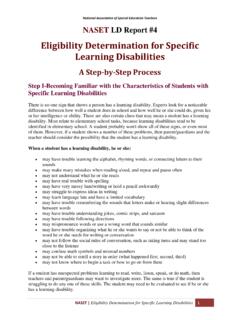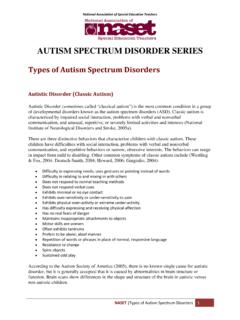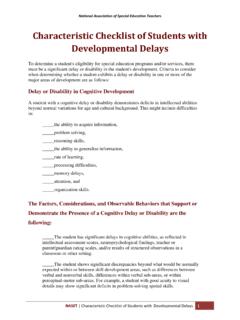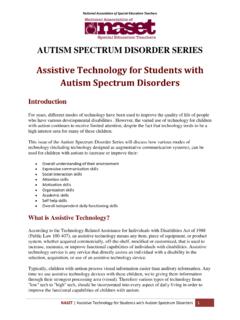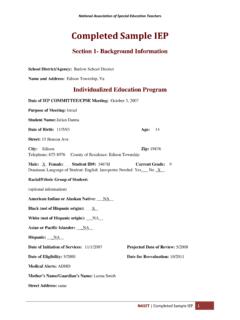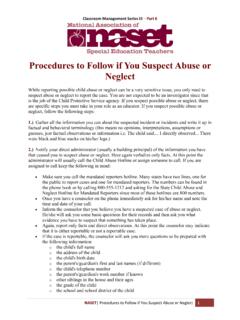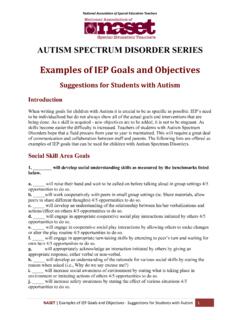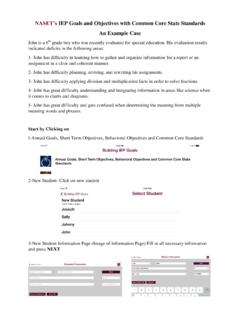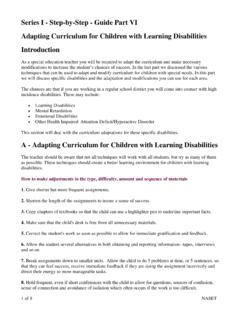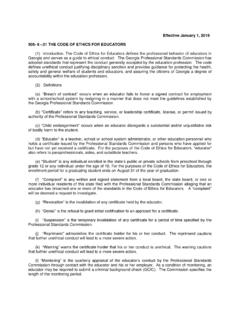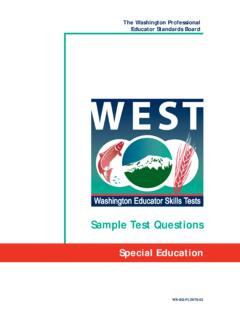Transcription of STAFF DEVELOPMENT in SPECIAL EDUCATION - NASET
1 STAFF DEVELOPMENT in SPECIAL EDUCATION Roles and Responsibilities of the SPECIAL EDUCATION Teacher AASEP s STAFF DEVELOPMENT Course Roles and Responsibilities of the SPECIAL EDUCATION Teacher Copyright AASEP (2006) 1 of 9 AASEP s STAFF DEVELOPMENT Course Roles and Responsibilities of the SPECIAL EDUCATION Teacher Copyright AASEP (2006) 2 of 9 As a SPECIAL educator you will come in contact with and be responsible for the educational needs of children with a wide range of disabilities. These children will also require a variety of different services, modifications and accommodations in their educational experiences.
2 Knowledge of each type of disability and the specific needs of the children with that disability are crucial if you plan to be or are already involved in the field of SPECIAL EDUCATION . The various categories of disabilities are clearly defined in the Individuals with Disabilities EDUCATION Act of 2004. These include: autism, deaf-blindness, emotional disturbance, hearing impairment (including deafness), mental retardation, multiple disabilities, orthopedic impairment, other health impairment, specific learning disability, speech or language impairment, traumatic brain injury, or visual impairment (including blindness).
3 The SPECIAL EDUCATION teacher in today s schools plays a very critical role in the proper EDUCATION of exceptional students. The teacher is unique in that he/she can fit many different roles in the educational environment. However, each of these distinct roles involves a variety of responsibilities and functions. Understanding these responsibilities can only help the SPECIAL educator become more familiar with the role and increase the chances for success. For instance, the SPECIAL EDUCATION teacher can be assigned to a variety of different educational situations.
4 The varying educational roles of a SPECIAL EDUCATION teacher are described in this course. AASEP s STAFF DEVELOPMENT Course Roles and Responsibilities of the SPECIAL EDUCATION Teacher Copyright AASEP (2006) 3 of 9 1- A teacher in a self contained SPECIAL EDUCATION classroom in a general EDUCATION school: This role would involve working with a certain number of disabled students in a SPECIAL EDUCATION setting. This type of setting allows for the use of mainstreaming, the involvement of a disabled child in a general EDUCATION classroom for a part of the regular school day, as an educational tool when a student is ready for this type of transitional technique.
5 The teacher in a self-contained classroom is usually assisted by a teaching assistant. In this type of setting the SPECIAL educator may be faced with a variety of responsibilities including but not limited to the following: Curriculum DEVELOPMENT Parent conferences Pre-and post testing using group standardized tests Involvement at the annual review-an annual meeting held by the IEP Committee to discuss the progress of each child with a disability and to plan the next year s Individual EDUCATION Plan Involvement in the triennial evaluation process-an evaluation that takes place every three years to determine if the conditions for the original classification are still present or need to be modified.
6 The requirement here would be limited to progress reports and recommendations for the following year. Monitoring the IEP, modifications and accommodations 2- The resource teacher in a categorical or non categorical resource room: A resource room in a SPECIAL school which deals with only one type of exceptionality is called a categorical resource room. A non categorical resource room is a resource room usually found in the regular mainstream school where children with varied exceptionalities are educated at one time. This type of role necessitates close involvement with each child's homeroom teacher and the transfer of practical techniques and suggestions to facilitate the child's success while in the general EDUCATION setting.
7 In this type of setting the SPECIAL educator may be faced with a variety of responsibilities including but not limited to the following: AASEP s STAFF DEVELOPMENT Course Roles and Responsibilities of the SPECIAL EDUCATION Teacher Copyright AASEP (2006) 4 of 9 Curriculum modification: here the resource teacher assists the classroom teacher in modifying the curriculum to meet the learning style and needs of the child with a disability Parent conferences Educational evaluator: in many cases the resource room teacher is asked to do the educational evaluations for initial evaluations, screening and triennial evaluations.
8 Pre-and post testing using group standardized tests Involvement at the annual review-an annual meeting held by the IEP Committee to discuss the progress of each child with a disability and to plan the next year s Individual EDUCATION Plan Involvement in the triennial evaluation process-an evaluation that takes place every three years to determine if the conditions for the original classification are still present or need to be modified. The requirement here would be limited to either discussion of test results or to update the progress of the student and recommendations for the following year.
9 Monitoring the IEP, modifications and accommodations 3- An educational evaluator on the Child Study Team (CST): The CST is a school based support team that discusses and makes recommendation on high-risk students. The role of an educational evaluator on this team requires a complete and professional understanding of testing and evaluation procedures, and diagnosis and interpretation of test results. In this type of setting the SPECIAL educator may be faced with a variety of responsibilities including but not limited to the following: Educational evaluator for initial evaluations (evaluations performed on students being classified for the first time).
10 Involvement in the triennial evaluation process-an evaluation that takes place every three years to determine if the conditions for the original classification are still present or need to be modified. Interpreting diagnostic results from outside evaluations AASEP s STAFF DEVELOPMENT Course Roles and Responsibilities of the SPECIAL EDUCATION Teacher Copyright AASEP (2006) 5 of 9 4-A member of the IEP Committee (depending on the state may also be referred to as the Committee on SPECIAL EDUCATION or IEP Committee): The IEP Committee is a district based committee mandated by Federal law whose responsibilities include the classification, placement and evaluation of all disabled children within the district.
